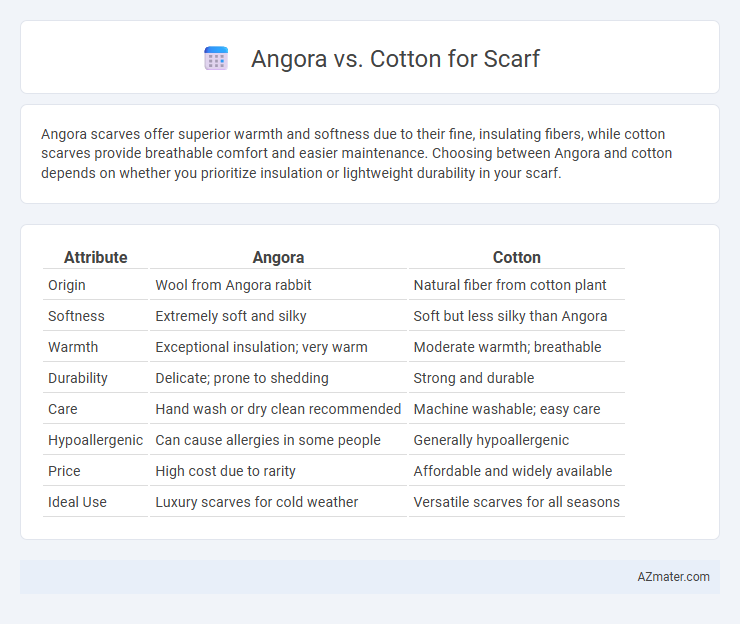Angora scarves offer superior warmth and softness due to their fine, insulating fibers, while cotton scarves provide breathable comfort and easier maintenance. Choosing between Angora and cotton depends on whether you prioritize insulation or lightweight durability in your scarf.
Table of Comparison
| Attribute | Angora | Cotton |
|---|---|---|
| Origin | Wool from Angora rabbit | Natural fiber from cotton plant |
| Softness | Extremely soft and silky | Soft but less silky than Angora |
| Warmth | Exceptional insulation; very warm | Moderate warmth; breathable |
| Durability | Delicate; prone to shedding | Strong and durable |
| Care | Hand wash or dry clean recommended | Machine washable; easy care |
| Hypoallergenic | Can cause allergies in some people | Generally hypoallergenic |
| Price | High cost due to rarity | Affordable and widely available |
| Ideal Use | Luxury scarves for cold weather | Versatile scarves for all seasons |
Introduction to Angora and Cotton Scarves
Angora scarves, crafted from the soft, lightweight fibers of Angora rabbits, offer exceptional warmth and a luxurious texture ideal for cold climates. Cotton scarves provide breathable comfort and durability, making them perfect for milder weather and daily wear. Choosing between Angora and cotton depends on the desired balance of insulation, softness, and breathability for scarf preferences.
Fiber Origins: Where Angora and Cotton Come From
Angora fiber comes from the Angora rabbit, primarily bred in regions such as Turkey, France, and China, known for its soft, silky texture and excellent insulation. Cotton fibers are derived from the seed hairs of the cotton plant, widely cultivated in countries like the United States, India, and Egypt, valued for its breathability and durability. Both fibers offer distinct natural origins, with Angora providing luxurious warmth and Cotton delivering lightweight comfort in scarves.
Texture and Softness Comparison
Angora scarves offer an exceptionally soft and fluffy texture due to the fine, hollow fibers of Angora rabbit hair, creating a luxurious and warm feel ideal for sensitive skin. Cotton scarves, while smooth and breathable, have a firmer texture and provide less insulation compared to Angora, making them more suitable for moderate climates. The inherent softness of Angora enhances comfort significantly, whereas cotton scores higher in durability and ease of care.
Warmth and Insulation Qualities
Angora scarves provide superior warmth and insulation due to their fine, hollow fibers that trap heat effectively, making them ideal for cold weather. Cotton scarves offer less insulation as their fibers allow more air circulation, which is better suited for mild temperatures. For optimal thermal retention in scarves, Angora outperforms cotton by maintaining body heat and providing a soft, lightweight barrier against cold winds.
Breathability and Comfort Factors
Angora scarves provide exceptional softness and warmth due to the fine fibers from Angora rabbits, making them highly comfortable in cold weather. Cotton scarves offer superior breathability and moisture-wicking properties, ideal for moderate temperatures and preventing overheating. Choosing between Angora and cotton depends on desired comfort levels and climate, with Angora excelling in insulation and cotton in airflow.
Durability and Maintenance Differences
Angora scarves offer luxurious softness but require delicate care, including hand washing and avoiding high heat to maintain fiber integrity. Cotton scarves boast higher durability, being machine washable and resistant to pilling, making them easier to maintain for everyday use. The natural durability of cotton fibers ensures longevity despite frequent cleaning, whereas Angora's delicate mohair fibers can degrade with improper handling.
Hypoallergenic and Skin Sensitivity Considerations
Angora wool is prized for its softness but can cause allergic reactions and irritation in individuals with sensitive skin due to lanolin and fine fibers. Cotton scarves offer excellent hypoallergenic properties and breathability, making them a safer choice for those prone to skin sensitivities or allergies. Selecting cotton reduces the risk of itching and inflammation while providing gentle comfort for delicate skin.
Style, Color, and Design Versatility
Angora scarves offer a luxurious texture with a natural sheen, enhancing style through rich, soft fibers that maintain warmth while providing a sophisticated look. Cotton scarves excel in color variety and ease of dyeing, making them ideal for vibrant, versatile designs that suit casual or formal wear. The lightweight nature of cotton enables more intricate patterns and prints, whereas Angora's plush fibers complement minimalist, elegant designs.
Environmental Impact and Sustainability
Angora wool, sourced from Angora rabbits, generally has a lower environmental footprint compared to conventional cotton due to its renewable and biodegradable nature, but ethical concerns about animal welfare can affect its sustainability reputation. Cotton cultivation requires substantial water usage and often involves pesticides, contributing to soil degradation and water pollution, which negatively impacts its environmental sustainability. Eco-conscious consumers prioritize organic or sustainably farmed cotton and cruelty-free Angora options to minimize environmental harm and support ethical production practices.
Choosing the Best Scarf: Angora vs Cotton
Angora scarves offer exceptional warmth and softness due to the fine fibers sourced from Angora rabbits, making them ideal for cold climates requiring insulation and luxury. Cotton scarves provide breathability and durability, perfect for mild weather and sensitive skin, with easy maintenance through regular washing. Choosing the best scarf depends on prioritizing thermal insulation and softness with Angora or lightweight comfort and practicality with cotton.

Infographic: Angora vs Cotton for Scarf
 azmater.com
azmater.com